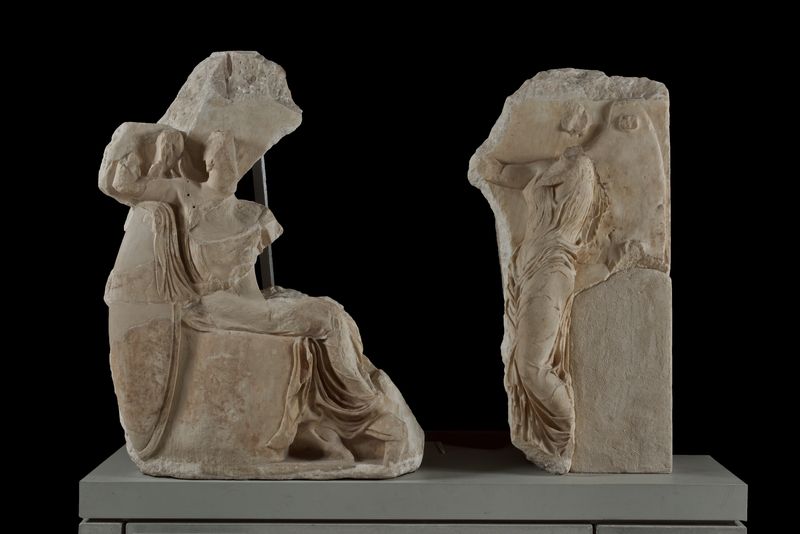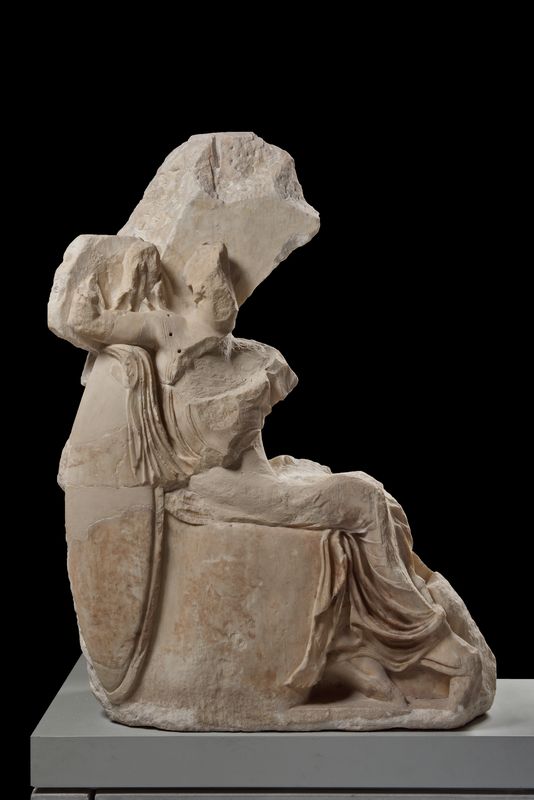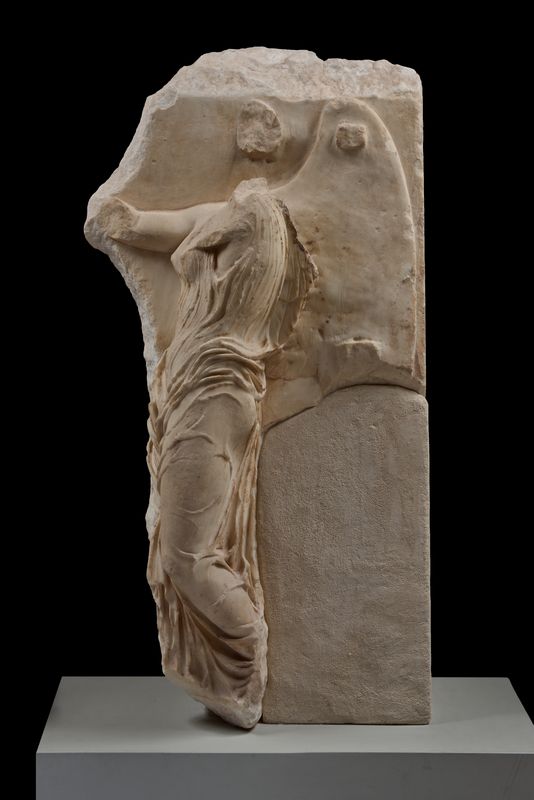Athena Nike Temple. Parapet. South-west corner slab. Athena and Nike
Inventory number
Ακρ. 974
Artist
Agorakritos' workshop
Category
Architectural sculpture
Period
Classical Period
Date
Around 410 BC
Dimensions
Height: 1.03 m
Length: 0.505 m
Width: 0.295 m
Material
Marble from Penteli
Location
First Floor, West
Fragments from one of the parapet’s corner slabs of the Temple of Athena Nike. The slab was decorated with relief scenes on its west and south faces. They were found at various locations, mainly on the Acropolis, and at different times. Two parts of the slab have been mended by joining fragments and restored.
On the left part that comes from the south side of the bastion Athena sits on the same rock on which her shield is placed upright. The goddess is draped in a chiton over which she has a himation. Her raised right hand rests elegantly on the shield while she pulls her himation with her fingers. On the other side of this fragment, which belongs to the parapet west side, preserved are parts of a Nike’s left wing and garment. The right part of the slab represents one more winged Nike clad in a thin chiton and himation. She stretches out her arms in order to adorn a trophy now lost. From her two wings remain only one and two projections which facilitated the adjustment of the second wing. A third projection is all that is left after her head was forcibly removed from the relief.The parapet enclosed the three sides of the bastion, on which the temple was built. It consisted of slabs approximately one meter in height whose outer surfaces were decorated with relief scenes visible by those ascending the Acropolis. The holes preserved on the upper surface of these slabs indicate that there was originally a metal railing, which further raised the height of the parapet.
The theme depicted on the parapet is a celebration of the military victories of the Athenians against their enemies, either Persians or other Greeks. The narrative is not continuous; instead it is composed of separate, individual scenes which – with slight variations – recur on each side of the parapet: winged Nikai lead bulls to sacrifice or hold weapons and adorn victory trophies with Greek or Persian armour. Among them sits goddess Athena, resting after victorious battles. The carving of the temple's sculptures was carried out by many different artists under the supervision of Agorakritos. These sculpted figures are highly representative of the end of the 5th cent. BC style called by archaeologists the "Rich Style".
In 1687 the temple and the parapet of Athena Nike were dismantled by the Ottomans and the material was used for the reinforcement of a gun emplacement and the fortification of the west side of the Acropolis against the attacks by the Venetians under the command of the general Francesco Morosini. Between 1835 and 1836 the gun emplacement was demolished and the Temple of Athena Nike was restored for the first time under the supervision of Ludwig Ross, the administrator of antiquities at the time. A second reconstruction was carried out in 1940, while a third was completed in 2010.
De Saulcy, F., M. de Saulcy, «Musée d' Athènes», Revue Archéologique 2e Année, No. 1, 1845, σελ. 272
Beulé, E., L'Acropole d'Athenes II, Paris, 1854, σελ. 259-260
Beulé, M., L' Acropole d'Athènes, Paris, 1862, σελ. 142-143
Michaelis, A., «Die Balustrade am Tempel der Athena Nike auf der Akropolis von Athen, Arch. Zeit», Archäologische Zeitung 20, 1862, σελ. 250-251, εικ. CLXII.1
Kekulé von Stradonitz, R., Die Balustrade des Tempels der Athena Nike in Athen, Leipzig, 1869, σελ. 22-23, 29, 31, πίν. I.C, II.H, αρ.κατ. 3, 9
Sybel, L. von, Katalog der Sculpturen zu Athen, Marburg, 1881, σελ. 359-360, εικ. 6, 10
Kekulé von Stradonitz, R., Die Reliefs an der Balustrade der Athena Nike, Stuttgart, 1881, σελ. 2, 6, 8, 16, 18-21, πίν. II.C, IV.M, αρ.κατ. C, M
Petersen, E., «Βιβλιοκρισία του R. Kekulé, Die Reliefs an der Balustrade der Athena Nike,», Zeitschrift für die Österreichischen Gymnasien, 32, Wien, 1881, σελ. 264, 265-267, 276
Friederichs, C., Wolters, P., Die Gipsabgüsse antiker Bildwerke, Berlin, 1885, σελ. 286
Le Bas, M.P., Reinach, S., Voyage Archéologique en Grèce et en Asie Mineure 1842-1844, σχολιασμένη έκδοση, Paris, 1888, σελ. 129, εικ. 12.II, αρ.κατ. II
Michaelis, A., «Die Zeit des Neubaus des Poliastempels in Athen», Mitteilungen des Deutschen Archäologischen Instituts. Athenische Abteilung 14, 1889, σελ. 365
Harrison, J.E., Mythology and Monuments of Ancient Athens, London, 1890, σελ. 363, εικ. 9
Yorke, V.W., «Newly Discovered Fragments of thw Balustrade of Athena Nike», Journal of Hellenic Studies 13, 1892/93, σελ. 274-276, εικ. 3
Overbeck, J., Geschichte der Griechischen Plastik, I, Leipzig, 1893-1894, σελ. 486-487, εικ. 125
Collignon, M., Histoire de la sculpture grecque II, Paris, 1897, σελ. 107, εικ. 52
Studniczka, F., Die Siegesgoettin, Leipzig, 1898, σελ. 22-23, εικ. 48, πίν. Χ
Petersen, E., Athen, Leipzig, 1908, σελ. 86-87, 90
Six, J., «Kalamis», Jahrbuch des Deutschen Archäologischen Instituts 30, 1915, σελ. 88
Casson, S., Brooke, D., Catalogue of the Acropolis Museum. Sculpture and Architectural Fragments, with a section upon the Terracottas, II, Cambridge, 1921, σελ. 139-143, εικ. 1-2, αρ.κατ. 1-2
Heberdey, R., «Die Komposition der Reliefs an der Balustrade der Athena Nike», Jahreshefte des Österreichischen Archäologischen Institutes in Wien 21-22, 1922-1924, σελ. 11-13, 22-23, 44, 52-53, 57-58, 63, 66, 77, 81, εικ. 7-8, 18
Blümel, C., Der Fries des Tempels der Athena Nike, Berlin, 1923, σελ. 21, 23, 26, εικ. II
Schrader, H., Phidias, Frankfurt am Mainz, 1924, σελ. 352, 354, εικ. 318, 320
Dinsmoor, W.B., «The Sculptured Parapet of Athena Nike», American Journal of Archaeology 30, 1926, σελ. 7, 9, 10, 12, 13, 16-23, 25-26, 28-30, εικ. 9
Carpenter, R., The Sculptures of the Nike Temple Parapet, Cambridge Massachusetts, 1929, σελ. 55-59,73, 80, εικ. 11, πίν. XXIV-XXV, αρ.κατ. 1-2
Carpenter, R., «The Sculptural Composotion of the Nike Parapet», American Journal of Archaeology 33, 1929, σελ. 475, 477, 479
Dinsmoor, W.B., «The Nike Parapet Once More», American Journal of Archaeology 34, 1930, σελ. 282-284, 286-287, 291-292, 294-295
Picard, C., F. Boissonas, L’Acropole d’Athenes, l’enceinte, l’entree, le bastion d’Athena Nike, les Propylees, Paris, 1930, σελ. 26, 28, εικ. 44, 48
Süsserott, H.K., Griechische Plastik des 4. Jahrhunderts vor Christus. Untersuchungen zur Zeitbestimmung, Frankfurt, 1938, σελ. 95 υποσημ. 8
Picard, C., La Sculpture II. Période Classique - Ve siècle, Manuel d'Archéologie Grecque II. 2, Paris, 1939, σελ. 773, 776, εικ. 301, 311
Blümel, C., «Der Fries des Tempels der Athena Nike in der attischen Kunst des 5. Jh. V. Chr.», Jahrbuch des Deutschen Archäologischen Instituts 65/66, 1950/51, σελ. 154
Giuliano, A., «Due frammenti de rilievi postfidiaci», Annuario della Scuola archeologica di Atene e delle Missioni italiane in Oriente 33/34, 1955/56, σελ. 54, εικ. 9
Lullies, R., Hirmer, M., Griechische Plastik von den Anfängen bis zum Ausgang des Hellenismus, München, 1956, σελ. 65-66, 101-102, εικ. 187b
Dohrn, T., Attische Plastik vom Tode des Phidias bis zum Wirken der grossen Meister des IV. Jahrhunderts v. Chr., Krefeld, 1957, σελ. 25 υποσημ. 50
Fuchs, W., Die Vorbilder der neuattischen Reliefs, Jahrbuch des Deutschen Archäologischen Instituts: Ergänzungsheft 20, 1959, σελ. 11 υποσημ. 19
Schlörb, Β., Timotheos, Jahrbuch des Deutschen Archäologischen Instituts: Ergänzungsheft 22, 1965, σελ. 41, εικ. 11
Adam, Sh., «The Technique of Greek Sculpture in the Archaic and Classical Periods», Annual of the British School at Athens, Suppl. 3, 1966, σελ. 54, 57-58, εικ. 26
Beschi, L, «Contributi di topografia ateniese», Annuario della Scuola archeologica di Atene e delle Missioni italiane in Oriente 45/46, 1967/68, σελ. 533, 535-536, εικ. 15, 17
Delivorrias, Α., «Die Kultstatue der Aphrodite von Daphni», Antike Plastik 8, 1968, σελ. 20 υποσημ. 7
Fuchs, W., Die Skulptur der Griechen, München, 1969, σελ. 443-444, εικ. 511
Boulter, P.N., «The Frieze of the Erechtheion», Antike Plastik 10, 1970, σελ. 21
Δεσπίνης, Γ., Συμβολή στη μελέτη του έργου του Αγοράκριτου, Αθήνα, 1971, σελ. 171-173
Hiller, F., Formgeschichtliche Untersuchungen zur griechischen Statue des späten 5. Jahrhunderts v. Chr., Mainz am Rhein, 1971, σελ. 70-71 υποσημ. 167
Μπρούσκαρη, Μ., Μουσείον Ακροπόλεως. Περιγραφικός κατάλογος, Αθήνα, 1974, σελ. 167, εικ. 332, αρ.κατ. 989
Pelikan, O., Übergangs - und Krisenperioden in der antiken Kunst. Phänomen des sog. Manierismus, Brnò, 1977, σελ. 32, εικ. 10
Heres, H., «Fragment einer attischen Giebelskulptur des späten 5. Jahrhunderts v.u.Z.», Forschungen und Berichte: Staatliche Museen zu Berlin 18, 1977, σελ. 10 υποσημ. 8, 12 υποσημ. 24
Mark, I., Nike and the Cult of Athena-Nike on the Athenian Acropolis, New York University, 1979, σελ. 159, 166, 170 υποσημ. 179, 174 σημ. 192, 178
Lullies, R., Hirmer, M., Griechische Plastik von den Anfängen bis zum Ausgang des Hellenismus, München, 1979, σελ. 101-102, εικ. 185
Ridgway, B.S., Fifth Century Styles in Greek Sculpture, Princeton, 1981, σελ. 97-98, 165, 199, 236, εικ. 74-77
Gulaki, A., Klassische und klassizistische Nikedarstellungen. Untersuchungen zur Typologie und zum Bedeutungswandel, Bonn, 1981, σελ. 130, εικ. 90
LIMC II, Athena, σελ. 732, αρ.κατ. 240
Simon, E., «Τα γλυπτά του ναού και του θωρακείου της Αθηνάς Νίκης», Αρχαιογνωσία 4, 1985, σελ. 22, 24-25, εικ. 7α
Szegedy-Maszak, A., «True Illusions: Early Photographs of Athens», The J. Paul Getty Museum Journal 15, 1987, σελ. 138, εικ. 20
Harrison, E.B., «Style Phases in Greek Sculpture from 450 to 370 BC», Πρακτικά του XII Διεθνούς Συνεδρίου Κλασικής Αρχαιολογίας, Αθήνα 4-10 Σεπτεμβρίου 1983, Γ, Αθήνα, 1988, σελ. 104
Di Vita, A., «La statua di Mozia», στο N. Bonacasa, A. Buttitta (επιμ.), La statua marmorea di Mozia e la scultura di stile severo in Sicilia: Atti della giornata di studio, Marsala, 1 giugno 1986, Roma, 1988, σελ. 47 και υποσημ. 28, πίν. XXVI.3
LIMC VI, Nike, σελ. 867, αρ.κατ. 186
Mark, I., «The Sanctuary of Athena Nike in Athens: Architectural Stages and Chronology», Hesperia Supplement 26, 1993, σελ. 90-91 υποσημ. 111, εικ. 22b
Μπρούσκαρη, Μ., Το θωράκιο του Ναού της Αθηνάς Νίκης, Αρχαιολογική Εφημερίς 1998 Αθήνα, (1999), σελ. 134-138, 162-166, εικ. 8-9, 79.2, 27-28, 29.1, 79.3
Patay-Horváth, A., Metallanstückungen an griechischen Marmorskulpturen in archaischer und klassischer Zeit, Tübinger Archäologische Forschungen 4, 2008, σελ. 81, αρ.κατ. 32
Λεβέντη, Ι., Πόλη σε κρίση, Αθήνα, 2014, σελ. 100-106









